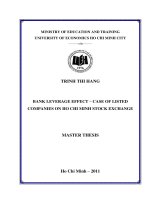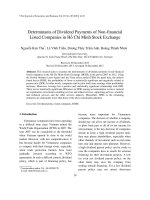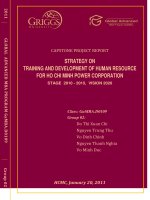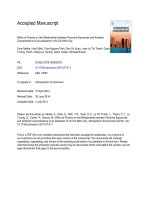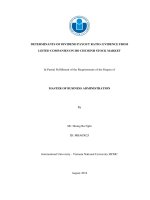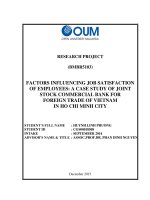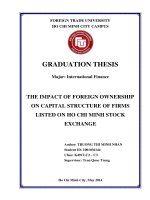(1)THE IMPACT OF FOREIGN OWNERSHIP ON CAPITAL STRUCTURE OF FIRMS LISTED ON HO CHI MINH STOCK EXCHANGE
Bạn đang xem bản rút gọn của tài liệu. Xem và tải ngay bản đầy đủ của tài liệu tại đây (1.92 MB, 108 trang )
FOREIGN TRADE UNIVERSITY
HO CHI MINH CITY CAMPUS
GRADUATION THESIS
Major: International Finance
THE IMPACT OF FOREIGN OWNERSHIP
ON CAPITAL STRUCTURE OF FIRMS
LISTED ON HO CHI MINH STOCK
EXCHANGE
Author: TRUONG THI MINH NHAN
Student ID: 1001036144
Class: K49CLC2 – C3
Supervisor: Tran Quoc Trung
Ho Chi Minh City, May 2014
TABLE OF CONTENT
List of abbreviation
List of tables and figures
INTRODUCTION ...................................................................................................1
CHAPTER 1: LITERATURE REVIEW ..............................................................4
1.1. Capital Structure.................................................................................................4
1.1.1. Relevant theories .............................................................................................4
1.2. Foreign ownership ............................................................................................15
1.2.1. Definition ......................................................................................................14
1.2.2. Legal framework of foreign ownership in Vietnam......................................16
1.3. The impact of foreign ownership on capital structure .....................................18
CHAPTER 2: THE IMPACT OF FOREIGN OWNERSHIP ON CAPITAL
STRUCTURE OF FIRMS LISTED ON HO CHI MINH STOCK EXCHANGE
.................................................................................................................................21
2.1. Research model ................................................................................................21
2.2. Variable description .........................................................................................24
2.3. Data collection ................................................................................................26
2.4. Research Findings ............................................................................................26
2.4.1. Descriptive statistics......................................................................................26
2.4.2. Correlation analysis .......................................................................................28
2.4.3. The regression results ....................................................................................30
2.5. Discussion ........................................................................................................33
CHAPTER 3: RECOMMENDATIONS FOR COMPANIES LISTED ON
HOSE AND THE GOVERNMENT AND SUGGESTIONS FOR FURTHER
RESEARCH...........................................................................................................36
3.1. Recommendations for companies ....................................................................36
3.1.1. Getting the optimal capital structure .............................................................36
3.1.2. Reducing the risk of bankruptcy ...................................................................39
3.1.3. Improving corporate governance ......................................................................
3.2. Recommendations for the government and competent authorities ..................47
3.2.1. Attracting foreign investment into Vietnam Stock Market ...........................47
3.2.3. Regulating corporate governance ..................................................................56
3.4. Limitations and suggestions for advancement .................................................57
CONCLUSION ......................................................................................................59
REFERENCE
APPENDIX
LIST OF ABBREVIATION
No.
Abbreviation
Explanation
1
BOD
Board of Directors
2
DATC
Debt and Assets Trading Corporation
3
ETF
Exchange-Traded Fund
4
FDI
Foreign Direct Investment
5
FEM
Fixed Effects Model
6
FII
Foreign Indirect Investment
7
HOSE
Ho Chi Minh Stock Exchange
8
OECD
9
OLS
Ordinary Least Square
10
REM
Random Effects Model
11
UPCOM
Unlisted Public Company Market
12
WTO
World Trade Organization
Organization for Economic Co-operation and
Development
LIST OF TABLES AND FIGURES
No.
1
2
3
Tables and Figure
Figure 1.1: The Modigliani and Miller theorem – Proposition I
and II
Figure 1.2: The static trade off theory of capital structure
Table 1.1: Differences between the two main kinds of foreign
investment
Page
7
10
15
4
Table 2.1: Descriptive Statistics
28
5
Table 2.2: The correlation matrix
29
6
Table 2.4: Regression results
31
1
INTRODUCTION
1. The necessity for the study
In the world of increasing globalization, foreign investment is a trend for all
companies over the world. Being a strongly emerging developing economy,
Vietnam has become an attractive market for investment inflows. As a matter of
fact, there has been a growing overseas cash flow into the country. In recent years,
foreign investment in the industrial sector in Vietnam has established the
development and promoting economic growth. In the few months between 2012 and
early 2013, the total amount of foreign net purchase on the secondary market
increased by nearly 20 times and the sector with overseas inflows owns the most
dynamic growth rate. Moreover, to be keep pace with the borderless trade as well as
pave the way for foreign funds into domestic companies, Vietnam government has
enacted The Law of Foreign Investment in Vietnam since 1987. Up to now, the law
has been amended many times and the latest amendment is in the beginning of 2014
to extend the maximum rate of foreign ownership in domestic commercial bank.
From this, it is indicated that foreign investment not only contributes to the process
of integration with the world economy of Vietnam but also plays a very important
role for our country's economy.
In the other hand, most of the Vietnam enterprises previously are owned by
the state and dependent on the funding from the government. However, in the
context of economic reform from the mid 80’s onwards, a number of enterprises
were privatized and rapidly developed with the diversity in ownership structure
such as private ownership, foreign ownership and joint-stock companies. That is
reflected by strong economic growth, the participation in the International Trade
Organization (WTO) and the establishment of Vietnam stock exchange market in
2000. The prosperity of corporations depends greatly on the access to appropriate
source of capital such as debt or equity, as well as determining the optimal capital
structure. Upon the advancement, Vietnam though is in lack of the diversity of
financial channels and empirical researches which are consistent with the reality of
capital structure so that they can support enterprises to make appropriate financing
decisions.
2
From the above reasons, it is essential to do an empirical research on the
impact of foreign ownership on capital structure in firms listed on Ho Chi Minh
Stock Exchange.
2. The research purposes
The purpose of this research is to study the impact of foreign ownership on the
capital structure of firms listed on Ho Chi Minh Stock Exchange.
3. The research object and scope
Object of the study: This study focuses on investigating the influence of
foreign ownership over financial leverage. Thus, the main objects of the study are
rate of foreign ownership and leverage. However, in order to reduce the bias of
other factors on the leverage, we utilize four more variables which are hypothesized
to have relationship with leverage.
Scope of the study: This study is conducted based on a panel data which is
collected from 249 firms with foreign ownership listed on Ho Chi Minh Stock
Exchange for the period from 2009 to 2013.
4. The research methods
In order to achieve the objective of this study, the author has applied
quantitative method approach. Specifically, a panel data is created from the data of
249 public firms listed in HOSE covering the period from 2009 to 2013 which is
collected from financial statements as well as the statistics of shareholders from a
recognized website.
A regression model is designed. Both Pooled Ordinary Least Square and Panel
data estimation method including fixed effects and random effects methods are
applied with the support of Eviews software version 6.0. Then, Hausman testing is
used to check the effectiveness between the two panel data methods.
5. The structure of the research
Besides the introduction, conclusion and references, the main content of the
research is structured with three chapters as follows:
Chapter 1: Literature review.
Chapter 2: The impact of foreign ownership on capital structure of firms listed
on Ho Chi Minh Stock Exchange.
3
Chapter 3: Recommendations for companies listed on HOSE and the
Government and suggestions for further research.
I would like to express my most sincere thanks to my supervisor, Master.Tran
Quoc Trung, who wholeheartedly gave me useful pieces of advice and solutions to
my concerns over the period of my completion of this research. Meanwhile, I would
like to show my great gratitude to the lecturers at Foreign Trade University, Ho Chi
Minh City Campus, who enthusiastically deliver the knowledge background and
offer the opportunity to do this research.
Due to the short duration for doing research and my limited ability, the
research inevitably contains many shortcomings despite my every effort. Therefore,
I would be greatly grateful if I could receive valuable comments from the supervisor
and instructors for a better and more practical content.
Ho Chi Minh City,10th May, 2014
Author
Truong Thi Minh Nhan
4
CHAPTER 1: LITERATURE REVIEW
1.1. Capital Structure
To maximize the shareholder’s value, each company has their own financing
decision to choose between borrowing and equity. In this very first section, it
reviews the theories of capital structure as well as definition of foreign ownership
employed in the study. Also, the summary of relevant research on the effects of
capital structure on capital structure is provided in the end of Chapter 1.
1.1.1. Relevant theories
In general, there are many ways for a firm generating fund for its operation as
well as business projects. Concerning the source, financing activities are divided
into internal funds and external channels.
When the chief financial officer considers raising capital for company, the first
source is internal source which comes from retained earnings. That is profit after tax
of the corporation accumulated from year to year. Thus, utilizing the available
capital is advantageous because of its low cost. The company does not bear the
interest for creditors or pay out the dividend for shareholders.
Regarding the external sources, borrowing and equity are two main ways for
financing. The former means loans from outside while the other refers to sell shares
including common stocks or preferred stocks to get investment for the company.
However, each type of source has its own benefit and risk.
As borrowing money, the company commits to pay an amount of interest
periodically and make principle repayment at maturity. However, the paid interest is
tax deductible, resulting in lower cost of capital. Lenders get their fixed return and
have no additional income if the project is successful and money – making. In other
hand, there are some risks such as lower liquidity ratios and higher solvency
indexes. That is disadvantageous for the firm due to higher cost of borrowing. In
addition, the amount of borrowings is in priority to pay back in circumstance of
bankruptcy.
Notwithstanding, companies have limited liability. It means that the promise
to repay the principle is not always kept. If the firm is in deep water, it is allowed to
default on debt and transfer their assets to the creditors.
5
In addition, there exists a kind of debt that can be converted into equity called
convertible bond. A convertible bond provides its owner the option to change to a
fixed number of shares. When company’s share price increases significantly, the
bond may be converted to get profit. Conversely as the stock price falls, there is no
obligation to turn the bond into equity. Owing to that privilege the convertible bond
is sold at a higher price or enjoys a lower interest rate than ordinary ones.
As a matter of fact, a company chooses to issue stocks for fundraising means
selling its ownership. Unlike debt, there are no principle and no interest while
dividend is paid out according to corporate policy, business profitability and type of
share. Yet, paid dividend is not allowed to deduct from taxable income since it is
calculated as an after tax payment.
As known, the firm’s net worth is a sum of common stocks and preferred
stocks. Although preferred equity is considered to be less important than the other,
there are certain particular situations in which it is a useful financing method such
as merging with other corporation. Like debt, there is a predetermined payment of
return regardless of the annual company bottom line and discretion of managers.
The company has rights not to pay the dividend but no dividend on common shares
is paid until that on preferred stocks is settled. If the firm goes bankruptcy, the
preferred stock holders take priority over the common share holder but queue after
the lenders. Moreover, it is not allowed to deduct dividends on preferred share from
taxable income, which is one of the dominant deterrents for industrial companies to
issue preferred (Brealey and Richard, 2001).
Other distinguishing character of preferred stock is limited voting rights. This
is favorable method for company to do financing without distributing control with
new stake holders.
By and large, the combination between debt and equity that a company utilizes
to raise capital for their operation is capital structure. The financial manager is
responsible for mitigating the cost of capital and maximizing the value of company
by choosing a proper capital structure.
However, principle–agent problem is worthy to consider. The conflict interest
between owners and managers often has impact on the financing decision. Also, the
6
announcement of new share issued sends a bad signal to public about the
profitability of business activities. While borrowings and debt certificate issuance
confirm the confidence in projects of company managers. Besides high financial
leverage is too risky because the great amount of interest payment will erode the
bottom line. This causes negative effect on financial situation of the company such
as liquidity, solvency and valuation ratios.
The theory of the Modigliani and Miller’s (1958) “Irrelevance theory of
capital structure” paved the way for other models of financial leverage of
economists.
Capital structure is the dominant controversies of scholars in modern corporate
finance in the latter half of 20th century. Up to now, there are four additional widely
acknowledged theories, which are divergent from the assumption of perfect market
applied by Modigliani and Miller. The first is the trade-off theory which assumes
that firms trade off the benefits and costs of debt and equity financing and find an
“optimal” capital structure after accounting for market imperfections such as taxes,
bankruptcy costs and agency costs. The second is the pecking order theory (Myers,
1984, Myers and Majluf, 1984) that argues that firms follow a financing hierarchy
to minimize the problem of information asymmetry between the firm’s managersinsiders and the outsider’s shareholders.
In addition, in 1976, Jensen and Meckling developed a research about agency
cost theory which has impact on corporate capital structure. That explains the
conflict interest of principle – agent resulting in the cost for firm to adjust the
deviation between two parties including manager – equity holder and debt holder –
share holder.
Recently, Baker and Wurgler (2002) have suggested a new theory of capital
structure: the “market timing theory of capital structure”. This theory states that the
current capital structure is the cumulative outcome of past attempts to time the
equity market. Market timing implies that firms issue new shares when they
perceive they are overvalued and that firms repurchase own shares when they
consider these to be undervalued. Market timing issuing behavior has been well
established empirically by others already, but Baker and Wurgler show that the
7
influence of market timing on capital structure is highly persistent.
1.1.1.1. The Modigliani and Miller theory
The theory of modern corporate finance is pioneered with the Modigliani and
Miller (1958) capital structure irrelevance proposition. Before them, no theory of
capital structure is generally acknowledged. Modigliani and Miller initially hold the
assumptions as followings
- Capital markets are perfectly competitive
- Investors have homogeneous expectation
- Riskless borrowing and lending
- No agency cost
- Investment decisions are unaffected by financing decisions
Modigliani and Miller (MM) theory includes the proposition I which proves
the value of the firm is unaffected by its capital structure and the proposition II
which explains the cost of equity increases linearly as a company increases its
proportion of debt financing. Both propositions are assumed to be excluded from
taxes.
Figure 1.1: The Modigliani and Miller theorem – Proposition I and II
(Source: Modigliani and Miller, 1958)
8
Their paper led subsequently to both clarity and controversy. As a matter of
theory, capital structure irrelevance can be proved under a set of restrictive
assumptions.
The 1958 paper stimulated serious research committed to relaxing the
irrelevance as a matter of theory or as an empirical matter. This research has shown
that the Modigliani-Miller theorem fails under various circumstances. The most
commonly used elements are taxes, transaction costs, bankruptcy costs, agency
conflicts, adverse selection, lack of separability between financing and operations,
time-varying financial market opportunities, and investor clientele effects.
Alternative models employ other factors from this list. Given the variety in
ingredients, it is not surprising that many different theories have been proposed. It is
beyond the scope of this paper to cover all of these.
As an empirical proposition, it is not easy to test the Modigliani-Miller
irrelevance proposition. With debt and firm value both plausibly endogenous and
motivated by other factors such as profits, collateral, and growth opportunities, we
cannot establish a testing model by regressing value on debt. But the fact that fairly
reliable empirical relations between a number of factors and corporate leverage
exist, while not disproving the theory, does make it seem an unlikely
characterization of how real businesses are financed.
“While the Modigliani-Miller theorem does not provide a realistic description
of how firms finance their operations, it provides a means of finding reasons why
financing may matter.” This argument provides a proper explanation of much of the
theory of corporate finance. Accordingly, it made such great impact on the initial
development of both the trade-off theory and the pecking order theory.
1.1.1.2. The trade off theory
The term trade-off theory is used by different authors to describe a family of
related theories. In all of these theories, a decision maker running a firm evaluates
the various costs and benefits of alternative leverage plans. Often it is assumed that
an interior solution is obtained so that marginal costs and marginal benefits are
balanced.
The original version of the trade-off theory grew out of the debate over the
9
Modigliani-Miller theorem. When corporate income tax was added to the original
irrelevance, this created a benefit for debt in that it served to shield earnings from
taxes. Since the firm's objective function is linear, and there is no offsetting cost of
debt, this implied 100% debt financing.
Several aspects of Myers' definition of the trade-off merit discussion. First, the
target is not directly observable. It may be imputed from evidence, but that depends
on adding a structure. Different papers add that structure in different ways. Second,
the tax code is much more complex than that assumed by the theory. Depending on
which features of the tax code are included, different conclusions regarding the
target can be reached.
Third, bankruptcy costs must be deadweight costs rather than transfers from
one claimant to another. The nature of these costs is important too. Fourth,
transaction costs must take a specific form for the analysis to work. For the
adjustment to be gradual rather than abrupt, the marginal cost of adjusting must
increase when the adjustment is larger.
This theory explains why the company with best business performance has the
lowest debt indicators. The firm makes less profit will be less funded from internal
capital and has to participate in the loans. In the long term, the value of the
company lies in the investment decision and its activities. As it is better to be the
first option of pecking order, the company always tries to maintain financial slack,
For example, the availability of financial resources (cash, liquid securities and other
assets, and the ability to borrow) is ready to make investment strategies, although
maintaining a conservative fiscal policy can make the conflict of interest between
principal and agent more serious.
When accumulated retained earnings are invested to opportunities which are
not really good , the BOD may take detrimental actions to the interests of the
owners and bringing particular benefits for themselves. A typical example is the
board of directors may use surplus funds to implement the non- acquisition - merger
which does not bring value to the company, aiming to increase power and their
paychecks. Or the board might spend a wasteful or inefficient cumulative value of
the owner. Michael Jensen (1986) emphasizes : "The problem is how to pay for the
10
board of directors instead of the lower capital cost investment or squandered them
in the inefficient operation " .
Conversely, capital structure employs a lot of debt, with fixed interest
payment and principal repayment putting pressure on the management of BOD
in more effective way than the company's cash flow. That helps regulate the BOD
avoiding risky investment, improving in its performance and minimizing conflicts
of interest between managers and shareowners.
Static trade-off theory
The static trade-off theory affirms that firms have optimal capital structures,
which they determine by trading off the costs against the benefits of the use of debt
and equity. One of the benefits of the use of debt is the advantage of a debt tax
shield. One of the disadvantages of debt is the cost of potential financial distress,
especially when the firm relies on too much debt.
Already, this leads to a trade-off between the tax shield and the higher risk of
financial distress. But there are more cost and benefits involved with the use of debt
and equity.
Figure 1.2: The static trade off theory of capital structure
(Source: The capital structure puzzle, Myers, 1984)
One other major cost factor consists of agency costs. Agency costs stem from
conflicts of interest between the different stakeholders of the firm and because of
11
ex-post asymmetric information (Jensen and Meckling (1976) and Jensen (1986)).
Hence, incorporating agency costs into the static trade-off theory means that a firm
determines its capital structure by trading off the tax advantage of debt against the
costs of financial distress of too much debt and the agency costs of debt against the
agency cost of equity. Many other cost factors have been suggested under the tradeoff theory, and it would lead to far to discuss them all. Therefore, this discussion
ends with the assertion that an important prediction of the static trade-off theory is
that firms target their capital structures, i.e. if the actual leverage ratio deviates from
the optimal one, the firm will adapt its financing behavior in a way that brings the
leverage ratio back to the optimal level.
- The Dynamic Trade-off Theory
Constructing models that recognize the role of time requires specifying a
number of aspects that are typically ignored in a single-period model. Of particular
importance are the roles of expectations and adjustment costs. In a dynamic model,
the correct financing decision typically depends on the financing margin that the
firm anticipates in the next period. Some firms expect to pay out funds in the next
period, while others expect to raise funds. If funds are to be raised, they may take
the form of debt or equity. More generally, a firm undertakes a combination of these
actions.
An important precursor to modern dynamic trade-off theories was Stiglitz
(1973), who examines the effects of taxation from a public finance perspective.
Stiglitz's model is not a trade-off theory since he took the drastic step of assuming
away uncertainty. Since firms react to adverse shocks immediately by rebalancing
costlessly, firms maintain high levels of debt to take advantage of the tax savings.
Dynamic trade-off models can also be used to consider the option values
embedded in deferring leverage decisions to the next period. Goldstein et al. (2001)
observe that a firm with low leverage today has the subsequent option to increase
leverage. Under their assumptions, the option to increase leverage in the future
serves to reduce the otherwise optimal level of leverage today. Again, if firms
optimally finance in periodical manner because of transaction costs, then the debt
ratios of most firms will deviate from the optimum nearly all the time. In the model,
12
the firm's leverage responds less to short-run equity fluctuations and more to longrun value changes.
Certain ideas are fairly general in dynamic models. The optimal financial
choice today depends on what is expected to be optimal in the next period. In the
next period, it may be optimal to raise funds or to pay them out. If raising new
funds, it might be optimal to raise them in the form of debt or in the form of equity.
In each case, what is expected to be optimal in the next period will help to pin down
the relevant comparison for the firm in the current period.
1.1.1.3. The pecking order theory
The pecking order theory does not take an optimal capital structure as a
starting point, but instead asserts the empirical fact that firms show a distinct
preference for using internal finance (as retained earnings or excess liquid assets)
over external financing choice. If internal funds are not enough to finance
investment opportunities, firms may or may not acquire external financing, and if
they do, they will choose among the different external finance sources in such a way
as to minimize additional costs of asymmetric information. The resulting pecking
order of financing is as follows: internally generated funds first, followed by
respectively low-risk debt financing and equity financing.
In Myers and Majluf model (1984), outside investors rationally discount the
firm's stock price when managers issue equity instead of riskless debt. To avoid this
discount, managers avoid equity whenever possible. The Myers and Majluf model
predicts that managers will follow a pecking order, prioritizing using internal funds,
then relying on risky debt, and finally resorting to equity. In the absence of
investment opportunities, firms retain profits and build up financial slack to avoid
having to raise external finance in the future.
The pecking order theory regards the market-to-book ratio as a measure of
investment opportunities. With this interpretation in mind, both Myers (1984) and
Fama and French (2000) note that a contemporaneous relationship between the
market-to-book ratio and capital structure is difficult to reconcile with the static
pecking order model. To the extent that high past market-to-book actually coincides
with high past investment, however, results suggest that such periods tend to push
13
leverage lower.
Empirical evidence supports both the pecking order and the trade-off theory.
Empirical tests to see whether the pecking order or the trade-off theory is a better
predictor of observed capital structures find support for both theories of capital
structure (Shyam -Sunder and Myers, 1999; Fama and French, 2002).
1.1.1.4. The agency cost of theory
An additional study on capital structure is the agency cost theory created by
Jensen and Meckling (1976). They came up with a new explanation which is
deviated from the M& M assumption. Agency costs are the costs associated with
the separation of owners and management. Managers do not have ownership in the
company so they are less likely to act at the shareholders’ best interest but their own
well-being. As being aware of the risk, stake holders take actions to alleviate the
costs. The appearance of a mechanism to address the difference in interest caused
the agency cost. There are three components of agency costs:
- Monitoring costs by the principle are the expense incurred to supervise the
performance of managers as well as make reports to stake holders and pay
salary to board of directors.
- Bonding costs by the agent are the expense incurred by management to ensure
the managers are acting at shareholder’s best interest.
- Residual loss occurred as a loss of owners’ well-being due to a divergence in
the agent’s decision.
In the research, it is implied that strong corporate governance will reduce the
agency cost and agency costs increase the cost of equity and reduce the value of the
firm. Also, it is suggested that the higher the use of debt relative to equity, the
greater the monitoring cost of the firm and, therefore, the lower the cost of equity.
Apart from the divergent interest between manager and shareholder, the agent
principle problem is also about the conflict of benefit between debt holders and
equity holders.
1.1.1.5. The market timing theory
The market timing theory of capital structure argues that companies time their
equity issues in the sense that they issue new stock when the stock price is
14
perceived to be overvalued, and buy back its own shares when there is
undervaluation. Consequently, fluctuations in stock prices affect firm’s capital
structures. There are two versions of equity market timing that lead to similar
capital structure dynamics.
The first assumes economic agents to be rational. Companies are assumed to
issue equity directly after positive information publishing which reduces the
information asymmetry problem between the firm’s management and stockholders.
The decrease in information asymmetry coincides with an increase in the stock
price. In response, companies create their own timing opportunities.
The second theory assumes the economic agents to be irrational (Baker and
Wurgler, 2002). Due to irrational behavior there is a time-varying mispricing of the
stock of the company. Managers issue equity when they believe its cost is
irrationally low and repurchase equity when they believe its cost is irrationally high.
It is important to know that the second version of market timing does not require
that the market actually be inefficient. It does not require managers to successfully
predict stock returns. The assumption is simply that managers believe that they can
time the market. In a study by Graham and Harvey (2001), managers admitted
trying to time the equity market, and most of those that have considered issuing
common stock report that "the amount by which our stock is undervalued or overvalued" was an important consideration.
This study supports the assumption in the market timing theory mentioned
above which is that managers believe they can time the market, but does not
immediately distinguish between the mispricing and the dynamic asymmetric
information version of market timing.
Baker and Wurgler (2002) provide evidence that equity market timing has a
persistent effect on the capital structure of the firm. They define a market timing
measure, which is a weighted average of external capital needs over the past few
years, where the weights used are market to book values of the firm. They find that
leverage changes are strongly and positively related to their market timing measure,
so they conclude that the capital structure of a firm is the cumulative outcome of
past attempts to time the equity market.
15
1.2. Foreign ownership
1.2.1. Definition
Foreign ownership refers to the complete or partial ownership/control of a
business in a country by individuals who are not citizens of that country, or by
companies whose headquarters are not in that country.
According to Clause 5 Article 3 of Investment Law 2005, foreign investors are
organizations and individuals to do capital investment in Vietnam.
Foreign investment in Vietnam is classified into two main types including
foreign direct investment (FDI) and foreign indirect investment (FII). Based on
Clause 2 Article 3 of Investment Law 2005, FDI is a form of investment in which
investors provide capital and participate in the management of investment activities.
While FII is form of investment through the purchase of shares, stocks, bonds and
other valuable papers, securities and investment funds through financial institutions
in which intermediate investors are not directly involved in the management of
investment activities.
Table 1.1: Differences between the two main kinds of foreign investment
FDI
FII
Purchase of stocks, bonds
Form of capital
investment
Capital contribution
Loans
and valuable papers
Via the investment funds
Via the intermediary
financial institutions
Form of
management
Direct involvement in
Indirect involvement in
investing activities
activities
(Source: Compiled by the author)
The forms of foreign indirect investment into Vietnam in accordance with
Circular 05/2014/TT-NHNN are as follows:
- Capital contribution, purchase and sale of shares, share capital in Vietnam
now which are unlisted and unregistered for trading on Vietnam's stock market
and not directly involved in managing and operating business.
- Capital contribution, purchase and selling shares of Vietnam enterprises in
16
Unlisted Public Company Market (UPCOM) as well as public stock market
and not directly involved in managing and operating business.
- Purchase and sales of bonds and other securities on the stock market in
Vietnam
Purchase and sell other valuable papers in Vietnam dong by resident
institutional entities which are allowed to issue on the territory of Vietnam.
- Trust investment in Vietnam dong through fund management companies,
securities companies and organizations which are permitted to engage in the
investment trust under the provisions of the securities laws; investment trusts
in Vietnam dong through credit institutions and branches of foreign banks
which are allowed to engage in the investment trust under the provisions of the
State Bank.
- Contribution of capital, capital transfer of foreign investors (not directly
involved in the management) in securities investment funds and fund
management companies under the provisions of the securities laws.
- The indirect investment forms prescribed by law.
1.2.2. Legal framework of foreign ownership in Vietnam
1.2.2.1. Requirement for foreign entities to contribute capital and buy stocks in
Vietnam
- Foreign investor as organization
Having an account opened at a commercial bank in Vietnam. All purchases
and sale of shares, capital transfer, collection and use of dividends, profit
sharing, transferring money overseas and other activities related to business
investment in Vietnam is conducted via this account
Providing copies of the business registration certificate or other equivalent
document to prove the legal status, certified by the competent authority of
the country where the organization has been registered;
Other conditions stipulated in the charter of the company that foreign
investors contribute capital and purchase shares in compliance with the
provisions of law.
- Foreign organization as individual
17
Having personal accounts opened at commercial banks in Vietnam. All
purchases and sale of shares, capital transfer, collection and use of
dividends, profit sharing, transferring money overseas and other activities
related to business investment in Vietnam is via this account
Providing copy of a valid passport
Other conditions stipulated in the charter of the company that foreign
investors contribute capital and purchase shares in compliance with the
provisions of law.
1.2.2.2. Forms of capital contribution and stock purchase
- Capital contribution
Foreign investors purchase the shares of a member of a limited liability
company, contributing capital to limited liability company to become a new
member of a limited liability company with two or more members or
purchasing the entire charter capital of the owner of a limited liability
company in order to become a new owner of a limited liability company
member.
Foreign investors repurchase the shares of the limited partners in a
partnership or making capital contribution to the partnership to become
members of the new capital contribution
Foreign investors as individuals purchase the shares of the partner in a
partnership or making capital contribution to the partnership to become a
new partner upon the approval of the members other partnerships.
Foreign investor acquires stake of private business owners or contribute
capital together with business owners to convert private businesses into
private limited liability company with two members or more and become
member of a limited liability company with two members or more.
- Purchase of shares
Foreign investors purchase shares of shareholders of joint-stock credit
institutions.
Foreign investors purchase shares in case where joint-stock credit
institutions sell shares to increase charter capital or sell treasury shares.
18
Foreign investors purchase shares in case where credit institutions
transform the legal form into joint-stock credit institutions.
1.2.2.3. Regulations on the proportion of capital contribution and stock
ownership of foreign entities in Vietnam
Based on Article 7 of Decree on Foreign Investors' Purchase of Shares of
Vietnamese Credit Institutions dated 01 March 2014, the shareholding percentage of
foreign investors is regulated as follows:
Shareholding percentage of a foreign individual shall not exceed 5% of
charter capital of a Vietnamese credit institution.
Shareholding percentage of a foreign organization shall not exceed 15% of
charter capital of a Vietnamese credit institution.
Shareholding percentage of a foreign strategic investor shall not exceed
20% of charter capital of a Vietnamese credit institution.
Shareholding percentage of a foreign investor and the concerned persons of
such foreign investor shall not exceed 20% of charter capital of a
Vietnamese credit institution.
Total shareholding level of foreign investors shall not exceed 30% of
charter capital of a Vietnamese commercial bank. Total shareholding level
of foreign investors at a Vietnamese non-banking credit institution shall
comply with legislation applicable to public companies and listing
companies.
Shareholding percentage of a foreign investor in a company other than
credit institution shall not exceed 49% of charter capital.
1.3. The impact of foreign ownership on capital structure
There are numerous researches on the influence of ownership over the choice
of capital structure with the different findings. In this section, a review on the prior
studies is classified based on the results.
According to most previous studies, foreign ownership has a negative impact
on the leverage ratio of the company. One of the typical studies that support this
notion is the study of Li et al (2009) conducted in Chinese companies which are not
listed on stock exchanges. The author found that foreign ownership is strongly and
19
negatively associated with large firms’ access to long-term debt, while the effect of
foreign ownership on small firms’ access to long-term debt is much smaller. This
suggests that small firms’ benefit from foreign ownership in their access to longterm debt. The research paper of Huang et al (2011) also studied the same issue in
China between 2002 and 2005 and achieved the same result with that of Li et al
(2009).
Gürsoy Gurunlu (2010) argued that enterprises with high level of foreign
ownership employ more borrowings than stocks because foreign investors help
them approach to new cheaper loans. As examining the impact of foreign investors
on the capital structure by using regression analysis with the data of non-financial
companies on the Istanbul Stock Exchange from 2007 to 2008, Gürsoy Gurunlu
(2010) concluded that foreign ownership makes significantly negative impact on the
long -term financial leverage. Because the companies often have enough internal
generated funds rather go into more debt for capital expenditure.
In contrary, as measuring the relationship of business in Australia in 20012009, Mishra (2012) concluded that foreign ownership has a positive correlation to
the financial leverage of the business. This seems contrary to the original
predictions. Authors suggest that firms with high leverage are less likely to attract
investors because leverage is often used to measure the financial distressing.
Investors generally prefer to invest in enterprise with high market book as the stock
with high market book value are often less risky. Additionally, Hussain and
Nivorozhkin (1997) reported the negative influence of overseas ownership on
leverage ratio, which is same as the findings of Kocenda and Svejnar (2002) and
Egger et al.(2010).
Meanwhile, Zou and Xiao (2006) and Huang and Song (2010) disagreed on
the above assumption and found the fact that foreign ownership has no significant
impact on the capital structure. More specifically, Zou and Xiao (2006) believed
that in emerging markets, foreign investors often face to the problem of asymmetric
information more than those in other countries. Therefore, it is inclined that foreign
investors invest more capital in businesses using more debts than equity. Also, in a
study of ownership structures, capital structures and firm performance – an
20
implication on privatization of Vietnamese state–owned enterprises, the author
pointed out that the capital structures are not correlation with ownership structure.
Furthermore, it is inferred that the correlation between leverage and the ratio of
Dominant Outsider Ownership and Dominant Foreign Ownership actually reflects
the relationship in which profitability is a mediator. In the same issue, the study of
P.D.Nam and L.T.P.Vy (2013) provides the positive relationship of foreign
ownership and leverage ratio of Vietnamese listed companies. The authors realized
the foreign investors in Vietnam are prone to information asymmetry and tend to
employ more debts for controlling agency problem.
In greater involvement of the international activities and cost of debt
financing, Singh and Neiadmalayeri (2004) found that internationalization leads to
higher long term debt ratio and lower cost of capital. That idea is supported by other
authors Agmon and Lessard (1977), Fatemi (1984) and David M. Reeb, Sattar A.
Mansi, John M. Allee (2001). In the other side, the positive linear relation between
level of internalization and cost of debt, considered as a barrier for firms to lever up
(Mansi and Reeb, 2002). This result is in line with Lee and Kwok (1998).
To sum up, the empirical researches lead to different results about the
relationship between foreign ownership and the ratio of debt employed in the
enterprise. In an emerging market like Vietnam, the overseas ownership is expected
to lower the leverage ratio in this study.
In conclusion, this chapter presents five theories of capital structure beginning
with M&M theory as a pioneer. Following researches on financial leverage are
pecking order theory, static and dynamic trade- off theory, market timing and
agency cost theory.
Then, the definition of foreign ownership in Vietnam is provided together with
legislation for foreign investors which is newly amended in 2014 in next section.
Finally, the last part is a summary of previous studies on the impact of foreign
ownership on capital and a theoretical prediction before analysis in Chapter 2.
